To determine the presence or absence of antigens or antibodies in a patient, many tests have been developed that use the interaction of antibodies and antigens. These tests require specificity and sensitivity. Specificity refers to the property of only binding to one antigen. Sensitivity means that the antibody can recognize and bind the antigen.
- Precipitation reactions depend on the interaction between antibodies and soluble antigens (acellular e.g. In the presence of electrolytes (NaCI), at a suitable temperature, pH and humidity
- These two insoluble reactants combine to form the precipitate, an insoluble product.
- Precipitate settles to bottom of tube in aqueous solution or appears as an opaque line (in gel).
- Antigen detection is sensitive to precipitation
- Precipitation tests can detect as little as 1g protein
- Precipitation, however, is less sensitive than other methods for the detection and measurement of antibodies.
- The following factors influence the amount of precipitate that is formed:
- The relative proportions of antibodies and antigens
- The Ab passion
What is Precipitation Reactions?
- A precipitation reaction, also known as a precipitin reaction, is a type of immuno or serological assay that involves the diffusion of antigen and antibody in liquid or semi-solid media. This reaction results in the formation of an immunocomplex or lattice at the point of equivalence where the antigen and antibody are in equilibrium. The lattice formed by the antigen and antibody becomes visible either as a precipitin ring or a precipitin line. The term “precipitin” refers to an antibody that reacts with its corresponding antigen to form a precipitate.
- Antibodies and antigens are complex structures composed of amino acids, with positive and negatively charged groups distributed on their surfaces in specific patterns. When antigen and antibody molecules are mixed, their electrical properties cause them to orient themselves based on their molecular shapes and charges, resulting in a precise fit between the two molecules.
- Precipitation reactions occur when soluble antigens react with IgG and IgM antibodies, leading to the formation of interlocking molecular aggregates called lattices. These reactions involve two distinct phases. The initial phase involves the rapid formation of small antigen-antibody complexes, which occurs within seconds. The second phase is a slower reaction where the antigen-antibody compounds form lattices that eventually precipitate from the solution. This second phase can take minutes to hours to complete.
- For precipitation reactions to occur, the antigen-antibody ratio must be optimal. Only when the concentration of both antigen and antibody is balanced will the immunocomplex form and precipitate. The sensitivity of precipitation reactions is relatively lower compared to other immunoassay reactions.
- In serology, various tests have been developed to detect the presence or absence of antibodies or antigens in a sample by utilizing the interactions between antibodies and antigens. Precipitation reactions involve the formation of insoluble complexes between soluble antigens and their specific antibodies in a suitable medium. A well-known example of a precipitation reaction is the ring test, also known as the precipitin ring test, which demonstrates the formation of a precipitin ring in a solution.
- Precipitation reactions are commonly used in serology for the qualitative and quantitative detection of antigens and antibodies. These reactions convert soluble reactants (antigens and antibodies) into aggregated forms. However, the sensitivity of precipitation reactions is lower compared to other immunoassay reactions.
- To perform a precipitation reaction, polyclonal or multivalent antibodies and antigens are used because the formation of lattices does not occur with monoclonal antigens and antibodies. The appearance of a precipitin ring or band may take several hours to days. Precipitation tests can be used to quantify both antigens and antibodies, and their specificity depends on the concentration of both reactants.
- If the concentration of either the antigen or antibody exceeds the other, the immunocomplex will not form. Therefore, for the reaction to occur, the concentrations of both the antigen and antibody must be equal, resulting in the visible formation of a precipitate or lattice. The end product of a precipitation reaction appears as a visible mass of precipitate, which can be measured using instruments such as turbidometers and nephelometers.
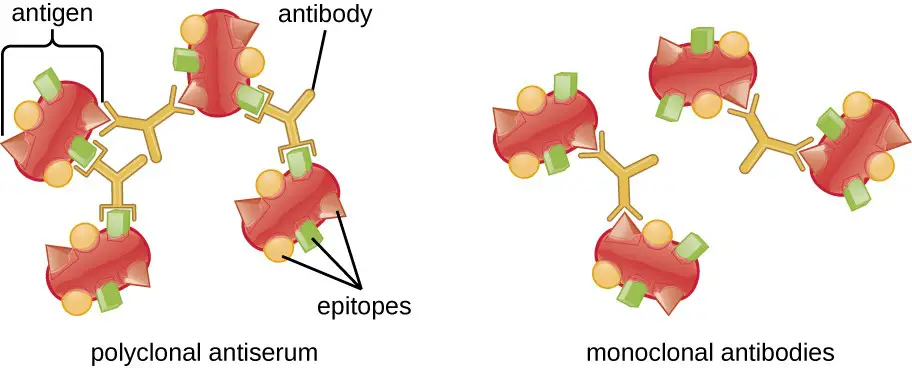
Definition of Precipitation Reaction
A precipitation reaction is an immunoassay or serological test in which soluble antigens and antibodies combine to form an insoluble complex, resulting in the formation of a visible precipitate or lattice.
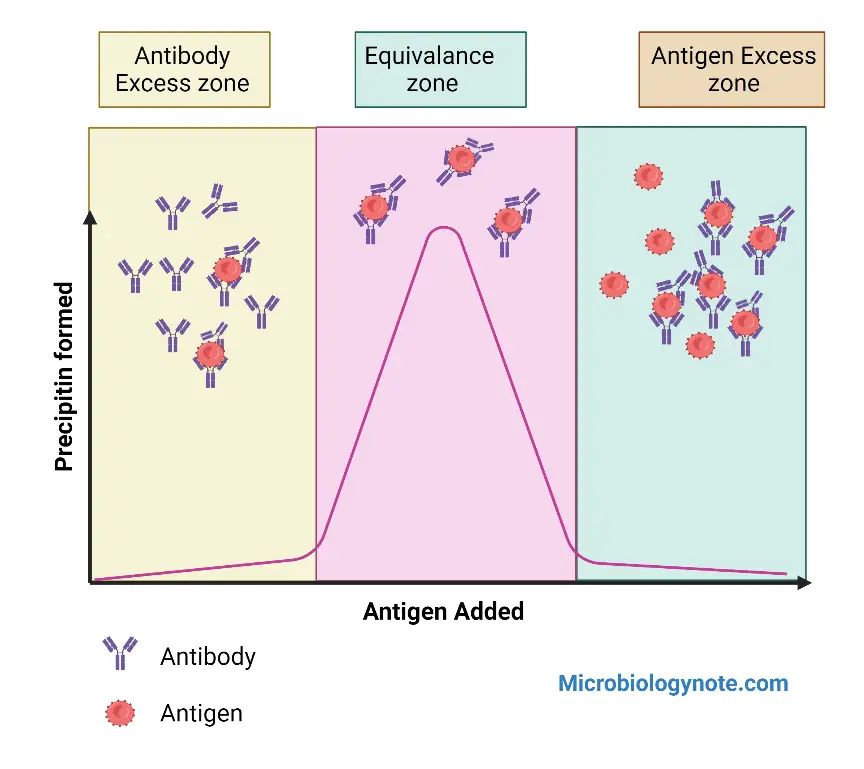
Figure 1 shows that there is no precipitate when one component is too high. Separate solutions of antigen or antibody should be placed next to each other so that they can diffuse together. This is the best way to get the best ratio. The concentration of antibody and antigen in the equivalence zone is where there is complete precipitation.
Objectives of Ring Precipitation Test
- To detect antigen-antibody complexes.
- Describe the conditions under which antigen-antibody compounds precipitate out of solution.
- It is possible to detect antibodies in patient serum, which can be used for diagnosing disease.
Principle of Ring Precipitation Test
The principle of the ring precipitation test is rooted in the concept of the antigen-antibody reaction, which occurs when the proper ratio of antigen to antibody is achieved. The test involves placing a solution containing the antiserum being investigated at the bottom of a series of clear test tubes. Increasing concentrations of a known antigen are then gently layered on top of the antibody solution.
If the test antiserum contains antibodies that recognize the antigen, immune complexes will form at the interface between the antigen and antibody solutions. These immune complexes appear as a whitish ring, indicating the formation of a visible precipitate, which can be flocculent or granular in turbidity.
The semi-quantitative results of the test can be determined by comparing the experimental outcomes with those obtained from a standard curve created using known quantities of antigen and antibody.
In the equivalence zone, where the ratio of antigen to antibody is balanced, cross-linkage occurs between the reactants, resulting in the formation of an antigen-antibody complex in the form of a visible ring or line of precipitate. The least soluble antigens and antibodies combine at the equivalence point, while the excess, unbound antigens and antibodies remain in the supernatant.
Requirements
To perform the ring precipitation reaction test, certain requirements and materials are needed. These include:
- Saline (0.85% NaCl): This is a solution of sodium chloride in water, commonly used as a diluent or medium for the test.
- Bovine globulin antiserum: This is a specific antibody preparation derived from bovine serum that is used to detect the presence of specific antigens in the test sample.
- Normal bovine serum: This is bovine serum that does not contain the specific antibodies of interest. It is used as a control and is diluted to different ratios, such as 1:25, 1:50, and 1:75, with physiological saline.
- 0.5ml pipettes: These small pipettes are used to accurately measure and transfer small volumes of liquids during the test.
- Serological test tubes (8 * 75mm): These tubes are specifically designed for serological assays and provide the necessary space for the test reagents to react and form precipitates.
- Incubator: An incubator is used to maintain a controlled temperature during the test. It ensures optimal conditions for the antigen-antibody reactions to occur.
- Serological test tube rack: This rack holds the test tubes in an organized manner, allowing easy handling and observation of the test results.
These requirements and materials are essential for conducting the precipitation reaction test accurately and effectively. They enable the proper mixing and incubation of the antigen, antibody, and diluents, leading to the formation of visible precipitates that indicate the presence of the specific antigen-antibody complexes.
Procedure of Ring Precipitation Test
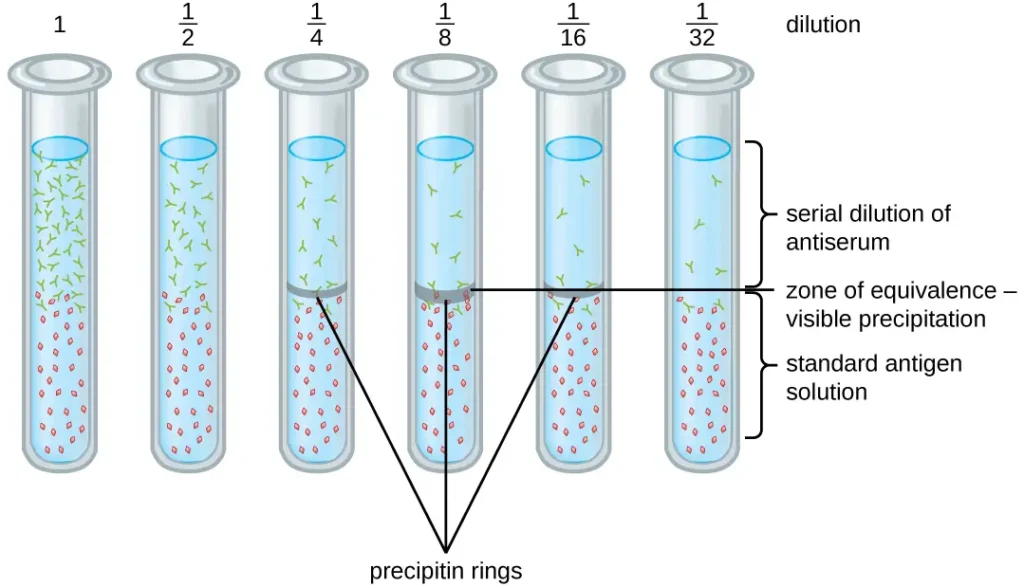
- Labeling the test tubes: Begin by labeling three serological test tubes according to the dilution of the antigen to be used, such as 1:25, 1:50, and 1:75. Additionally, label the fourth test tube as the saline control.
- Transferring normal bovine serum: Using a different 0.5-ml pipette for each dilution, transfer 0.3 ml of the normal bovine serum into its corresponding labeled test tube. Ensure that each dilution is accurately transferred.
- Adding the saline control: Take a clean 0.5-ml pipette and transfer 0.3 ml of saline solution into the test tube labeled as the control. This serves as a reference for comparison during the test.
- Overlaying with bovine globulin antiserum: Carefully overlay all four test tubes, including the control, with 0.3 ml of bovine globulin antiserum. Take care to tilt the test tubes slightly to prevent mixing of the sera, allowing the antiserum to run down the side of the test tube.
- Incubation: Place all the test tubes in an incubator set to a temperature of 37°C. Incubate the test tubes for a duration of 30 minutes. This controlled environment promotes the interaction between the antigen and antibody.
- Examination for ring formation: After the incubation period, examine all the test tubes for the development of a ring of precipitation at the interface between the liquid layers. Note and indicate the presence or absence of a ring in the Lab Report.
- Determining optimal antibody-antigen ratio: Identify and record the antigen dilution that exhibits the greatest degree of precipitation. This indicates the optimal antibody-antigen ratio for the test and provides valuable information about the strength of the interaction.
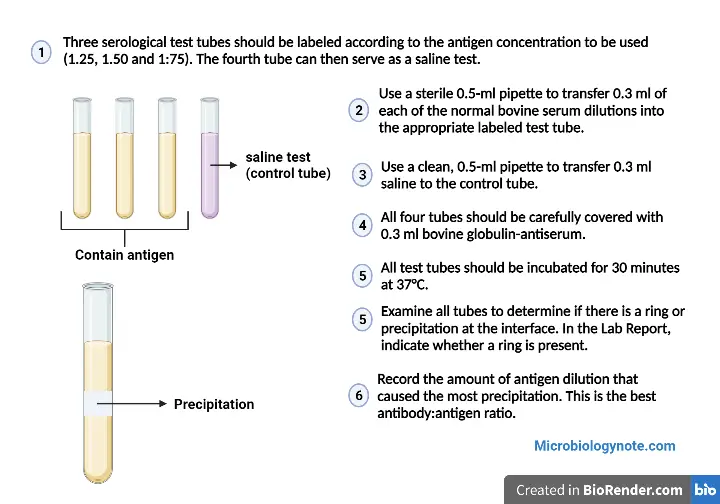
Results Interpretation of Ring Precipitation Test
The interpretation of the results obtained from the ring precipitation test is as follows:
- Positive Ring Test: If a white ring is observed at the junction of the antiserum and antigen solution, it indicates a positive result. The presence of this visible white ring confirms the formation of antigen-antibody complexes, suggesting that the test sample contains the specific antibody capable of reacting with the antigen.
- Negative Test: On the other hand, if no white ring formation is observed at the interface of the two liquid layers, it indicates a negative result. The absence of a visible ring suggests that there is no interaction between the antigen and the specific antibody present in the test sample.
The presence or absence of the white ring in the ring precipitation test serves as the basis for interpreting the results. A positive result indicates the presence of antigen-antibody complexes, while a negative result suggests no such interaction. It is important to carefully observe and note the presence or absence of the ring formation during result interpretation.
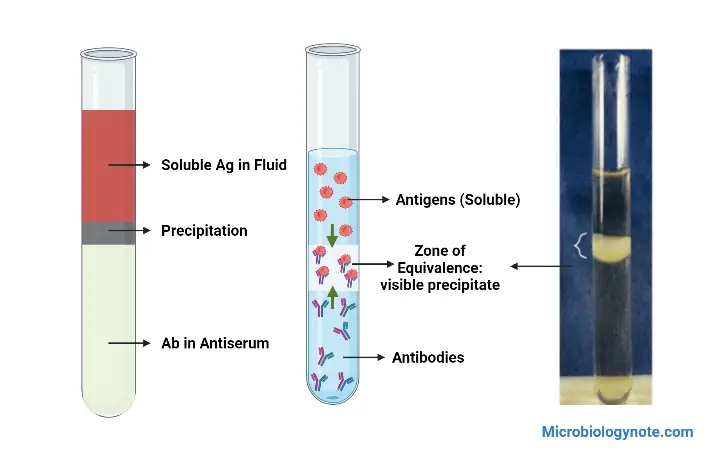
Advantages of Ring Precipitation Test
- Quick and simple: The ring precipitation test is a relatively rapid and straightforward method for detecting the presence of antigen-antibody complexes. It does not require sophisticated equipment or extensive technical expertise, making it easily accessible and applicable in various laboratory settings.
- Qualitative and semi-quantitative results: The test allows for qualitative assessment, providing a clear positive or negative result indicating the presence or absence of a visible ring of precipitation. Additionally, by comparing the degree of precipitation among different antigen dilutions, semi-quantitative information can be obtained, giving an indication of the optimal antibody-antigen ratio.
- Cost-effective: The materials required for the ring precipitation test, such as serological test tubes, pipettes, and reagents, are generally inexpensive and readily available. This makes the test cost-effective, especially when screening a large number of samples.
- Versatility: The ring precipitation test can be utilized for a variety of applications, including the detection of specific antibodies or antigens in different biological samples. It can also be adapted to assess the interaction between various antigen-antibody pairs, making it versatile and widely applicable in immunological research and diagnostic settings.
Disadvantages of Ring Precipitation Test
- Subjectivity in interpretation: The visual observation of a visible ring of precipitation is subjective and can vary depending on the operator’s perception. The interpretation of results may be influenced by individual variations, leading to potential inconsistencies or discrepancies in result interpretation.
- Limited sensitivity: Compared to some other immunoassay techniques, such as enzyme-linked immunosorbent assay (ELISA) or polymerase chain reaction (PCR), the sensitivity of the ring precipitation test may be relatively lower. It may not detect low levels of antigen-antibody complexes, resulting in false-negative results in certain cases.
- Lack of quantification: The ring precipitation test provides qualitative or semi-quantitative results but does not offer precise quantification of antigen or antibody levels. It may not be suitable for situations that require accurate quantification, such as determining the concentration of specific antigens or antibodies in a sample.
- Limited dynamic range: The ring precipitation test is primarily suited for detecting antigen-antibody reactions within a specific range of concentrations. It may not be effective for samples with extremely high or low concentrations of the target antigen or antibody, as it relies on the optimal antibody-antigen ratio for precipitation formation.
Uses of Ring Precipitation Test
The ring precipitation test finds utility in various applications, including the following:
- C-reactive protein (CRP): The ring precipitation test can be employed for the detection and quantification of C-reactive protein (CRP). CRP is an acute-phase protein that increases in response to inflammation. By performing the ring precipitation test with specific antibodies against CRP, the presence and level of CRP in a patient’s sample can be determined.
- Lancefield grouping of β-haemolytic streptococci: The ring precipitation test is utilized in the Lancefield grouping of β-haemolytic streptococci. Lancefield grouping involves the classification of streptococci based on the presence of specific carbohydrate antigens on their cell walls. The ring precipitation test, using specific Lancefield antisera, helps identify the serological group to which a particular strain of β-haemolytic streptococcus belongs.
- Ascoli’s thermoprecipitin test for anthrax diagnosis: The ring precipitation test, also known as Ascoli’s thermoprecipitin test, plays a crucial role in the diagnosis of anthrax. This test involves the detection of antibodies against the protective antigen of Bacillus anthracis, the causative agent of anthrax. By subjecting the antigen-antibody mixture to heat and observing the formation of a ring precipitate, the presence of antibodies against the protective antigen can be determined, aiding in the diagnosis of anthrax.
FAQ
What is a ring precipitation test?
A ring precipitation test is a serological assay used to detect the presence of antigen-antibody complexes. It involves the formation of a visible ring of precipitation at the junction of the antigen and antibody reaction.
What are the applications of the ring precipitation test?
The ring precipitation test is used in various applications, including the detection and quantification of specific proteins like C-reactive protein, Lancefield grouping of streptococci, and the diagnosis of anthrax.
How is the ring precipitation test performed?
In the ring precipitation test, specific antigens or antibodies are mixed with their corresponding counterparts in serological test tubes. After incubation, the presence or absence of a visible ring of precipitation at the interface is observed.
What is the principle behind the ring precipitation test?
The ring precipitation test is based on the principle of antigen-antibody interaction. When the proper ratio of antigen to antibody is reached, cross-linked precipitates form, resulting in the visible ring of precipitation.
What are the advantages of the ring precipitation test?
The advantages of the ring precipitation test include its simplicity, cost-effectiveness, qualitative and semi-quantitative results, and versatility in different immunological applications.
What are the limitations of the ring precipitation test?
The limitations of the ring precipitation test include subjective result interpretation, limited sensitivity compared to other immunoassays, lack of quantification, and a limited dynamic range.
How long does it take to perform a ring precipitation test?
The incubation time for a ring precipitation test can vary depending on the specific antigen-antibody system being tested. It can range from a few minutes to several hours.
Can the ring precipitation test be used for quantitative analysis?
The ring precipitation test provides semi-quantitative results by comparing the degree of precipitation among different antigen dilutions. However, it does not offer precise quantification of antigen or antibody levels.
Are there any alternative methods to the ring precipitation test?
Yes, there are alternative methods for antigen-antibody detection, such as enzyme-linked immunosorbent assay (ELISA), immunofluorescence, and Western blotting, which may offer higher sensitivity and quantification capabilities.
Is the ring precipitation test still widely used in modern laboratories?
While the ring precipitation test may have certain limitations, it is still utilized in specific applications where qualitative or semi-quantitative analysis is sufficient, or when cost-effectiveness and simplicity are priorities. In some cases, it may serve as a screening test before employing more sensitive and quantitative methods.
References
- WALSHE JM, LACHMANN PJ, ORREGO-MATTE H. A ring precipitin test in chronic liver disease: a study of the false positive. Immunology. 1961 Jul;4(3):232-5. PMID: 13782928; PMCID: PMC1424043.
- Deshmukh, Amol & Dighe, Pravin & Tiwari, Kundan & Garud, Supriya. (2020). PRECIPITATION REACTIONS IN IMMUNOLOGY. EUROPEAN JOURNAL OF PHARMACEUTICAL AND MEDICAL RESEARCH. 7. 214-216.
- Boyden, A. (1963). Precipitin Testing and Classification. Systematic Zoology, 12(1), 1. doi:10.2307/2411889
- https://www.chegg.com/homework-help/questions-and-answers/precipitin-ring-test-1-purpose-incubating-09-saline-equine-albumin-antiserum-tube-b-specif-q36542660
- https://www.biosciencenotes.com/types-of-precipitation-reaction/
- https://www.brainkart.com/article/Types-of-precipitation-reactions—Antigen-Antibody-Reactions_17919/
- https://biologyreader.com/precipitation-reaction.html
- https://jamanetwork.com/journals/jama/article-abstract/217950
- https://www.jimmunol.org/content/28/2/95
- https://www.sciencedirect.com/topics/medicine-and-dentistry/precipitin
- https://www.ncbi.nlm.nih.gov/pmc/articles/PMC1424043/
- http://ecoursesonline.iasri.res.in/mod/page/view.php?id=61850
- https://www.biologyonline.com/dictionary/ring-test
- Text Highlighting: Select any text in the post content to highlight it
- Text Annotation: Select text and add comments with annotations
- Comment Management: Edit or delete your own comments
- Highlight Management: Remove your own highlights
How to use: Simply select any text in the post content above, and you'll see annotation options. Login here or create an account to get started.